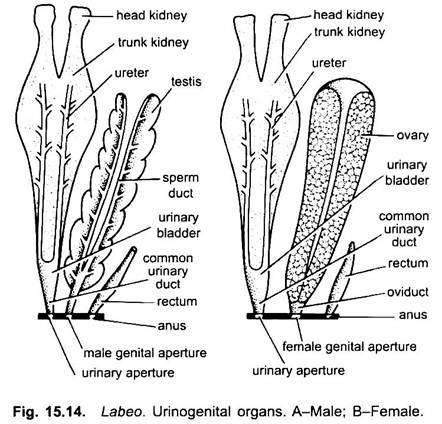Sexes are separate. The excretory and reproductive organs in male and female are quite separate in Labeo.
Excretory Organs:
The kidneys are of large size, extending the whole length of the abdominal cavity. They are placed dorsally above the air bladder, and partly fused together in the middle region. Anteriorly both the kidneys are free. Their anterior ends are much dilated and consist of lymphatic tissue in the adult, thus, ceasing to discharge a renal function. They are mesonephric type (derived from the mesonephros of the embryo).
The mesonephric ducts or ureters arising from the kidneys unite into a single tube, which is dilated to form a urinary bladder. It opens into the urinogenital sinus. Urinary bladder is mesodermal in origin and is not homologous with the endodermal bladder of higher vertebrates. Fishes are ammonotelic, i.e., they excrete nitrogenous metabolites largely in the form of ammonia, though some urea is formed and discharged.
Reproductive Organs:
The gonads are of great size in the sexually mature fish. In the male, the testes are paired, extending the whole length of the abdominal cavity beneath the air bladder. Each testis is continued posteriorly into a genital duct which opens into the urinogenital sinus. The spermatozoa are shed into the external medium.
In the female, ovaries are also paired, running the whole length of the abdominal cavity beneath the air bladder. They are much wider than the testes and are covered with peritoneum only on their inner faces. The oviducts are not found. The ova are discharged when ripe from their outer faces into the coelom.
The anterior wall of the urinogenital sinus is pieread by a pair of genital pores formed temporarily through which ova escape out into the water. Genital pores are not homologous with the abdominal pores of the cartilaginous fishes.
Fertilisation:
Labeo is oviparous. Fertilisation is external. The male sheds its seminal fluid on the new-laid eggs. The ovum is covered by a thick membrane, the zona radiata. This is perforated by an aperture, the micropyle, through which a sperm enters.
ADVERTISEMENTS:
Hatching occurs within 2 to 15 hours. Hatchlings have a prominent yolk sac attached to the ventral side of the body. Yolk sac is absorbed in 5-7 days and the new young ones called fry begin to feed. They start feeding with fringed lips and grow into fingerlings measuring about 5-15 mm in length. They attain sexual maturity in about two years.
